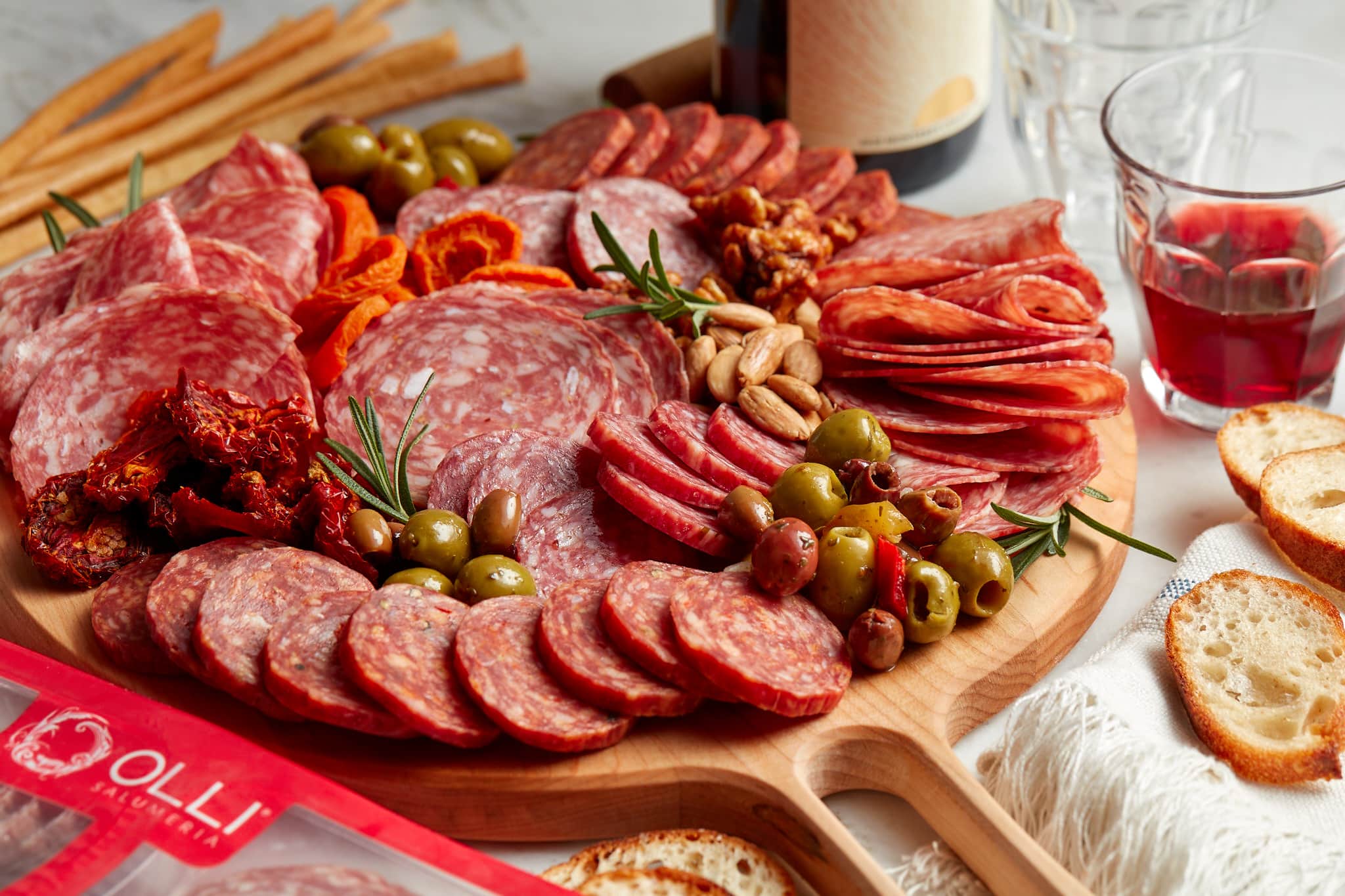Cured meats, charcuterie, salumi and salami. These all describe a family of delicious sliced and cubed meats that grace sandwiches, cheese boards, and crostinis the world over. But what are cured meats exactly? How are they cured? How can you enjoy cured meats to the fullest?
What are cured meats?
Cured meats are any meat that undergoes a preserving process, involving curing with salt, fermenting, drying, or a combination. During the curing process, the meats lose almost all of their moisture, leaving the resulting product with a lengthened shelf life and a unique flavor. Meat is a very perishable food. Before the days of proper refrigeration, it needed to be preserved to last, especially during times of famine or scarcity.
Meat has been cured since the earliest days of mankind. Traces of unfinished meals found by archaeologists tell us that meats were being cured even before recorded history. The ancient process of using salt or drying to extend the life of foods has been well-documented throughout ancient civilizations, starting as early as 3000 BCE with the Mesopotamians. Ancient Roman writer Cato wrote detailed instructions on how to salt cure meat and vegetables as early as 234 BCE, urging the necessity of preserving perishable foods to extend their shelf life.
Today, traditional methods for curing meat are still used all across the world. Almost every country has its own kinds of cured products. Many of the cured meats we have in the US are either imported or crafted using traditional techniques from Italy, France, or Spain, such as the salumi from Olli Salumeria. These traditional methods of curing meat create uniquely delicious charcuterie made without added preservatives or chemicals.
What are some of the ways meat can be cured?
Salt curing
Perhaps the oldest method of curing meat is salt curing, which utilizes either a dry salt rub or a salt brine to preserve the meat. Salt inhibits the growth of harmful bacteria by drawing moisture out of the meat and out of the cells of microorganisms, effectively killing them off before they can reproduce and cause spoilage.
Salt curing generally involves a mixture of ingredients that aid in preservation and enhance the final taste of the product. This can include salt, sugar, nitrates, and spices. It was discovered in the early 1800s that saltpeter, which contains nitrates, resulted in cured meat that was pink instead of the gray of traditional salt-only cures. Nitrates also inhibit the growth of other dangerous strains of bacteria, resulting in cured meats that are shelf-stable and can be eaten without refrigeration.
What about Nitrates and Nitrites?
Today, a majority of salt cured products are made with the addition of specialized curing salt, which includes nitrates or nitrites that preserve the meat and its color, making it shelf stable. Nitrates and nitrites themselves aren’t inherently harmful, and are often included in such small amounts in cured meat that their content is almost negligible.
Where sodium nitrite gets a bad rap is the possibility that it can form carcinogenic compounds when high heat is applied. However, in modern meat processing, the use of nitrates is so strictly controlled that meats often end up with little to no nitrites in the finished product. In addition to this, products like bacon have added Vitamin C that inhibits the reaction that causes these compounds to form.
Naturally found in high levels in green leafy vegetables, the nitrates used in curing salts and those found in plants are chemically identical. In fact, even products labeled as “uncured” have had nitrates added in the form of those naturally occurring in celery and other vegetables.
Cured meats made with traditional European techniques, however, like those from Olli Salumeria, never require the addition of nitrates or nitrites to be shelf stable. Olli’s salumi are made only with natural ingredients and recipes for an incredibly delicious cured meat you can enjoy without any worry over nitrates and nitrites at all.
Fermentation
Often used to make products like salamis, sausages, and pepperoni, fermentation of meat involves the use of lactic acid starter cultures to cure. The cultures that are added to the meat during the fermentation process eat the carbohydrates in the meat and the seasonings and produce lactic acid. This in turn prevents harmful bacteria from growing while the meat dries, and gives deli meats like pepperoni their distinctive tangy flavor.
Olli’s fermentation process also creates an artisanal salami with a thin rind of beneficial white mold that hugs the outside casing. The mold never touches the salami inside, and actually helps to keep the final product from spoiling. The rind can be easily removed by making a shallow cut up the length of the salami and peeling back the rind to reveal the meat beneath. Then simply slice and enjoy!
Drying
Drying or dehydrating meat involves simply cooking on a very low heat until all of the moisture in the meat has evaporated. Without moisture, bad bacteria and mold have nothing to bind with, keeping the meat from spoiling. This technique is most commonly used to make jerky and can be used on nearly any type of meat. In the right climate, meat can be dried with only the heat of the sun, but the safest way is to use a dehydrating machine to get your jerky fix.
Meat can also be dried in the low heat of a smoker, which adds an additional layer of smoky flavor to the finished product.
Combination Curing
Combination curing is a method of curing that is most often used for ham. It involves both a dry salt cure and a brine cure, with the brine being injected into the meat to speed up the curing process. Hams are cured in this method, and then cooked before being packaged for sale.

How can I use cured meats?
The latest trend for cured meats is, of course, the charcuterie board. Pile your board up high with Olli salami, prosciutto, and other cured meats to start. You want to budget about 2 oz of cured meat per person on your board, to make sure everyone gets a taste. Then add cheeses of your choice, and your favorite accoutrement! A charcuterie board is a great way to explore different textures, tastes, and appearances all in one place. Try adding nuts, dried or fresh fruits, honey, olives and pickles, and your favorite crackers for a gorgeous board to get the party started.
You can also enjoy cured meats by themselves or on a cracker, wrapped around crunchy breadsticks, or stacked onto an incredible sandwich. However you serve them, these meats really do have the “cure” for your protein cravings.
Products Mentioned
Leave a Comment
Latest Posts
Salts of the Earth: A Guide to Celtic Sea Salt & Sel Gris
Learn more about delicious Celtic Salt and Sel Gri

















